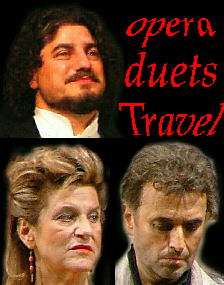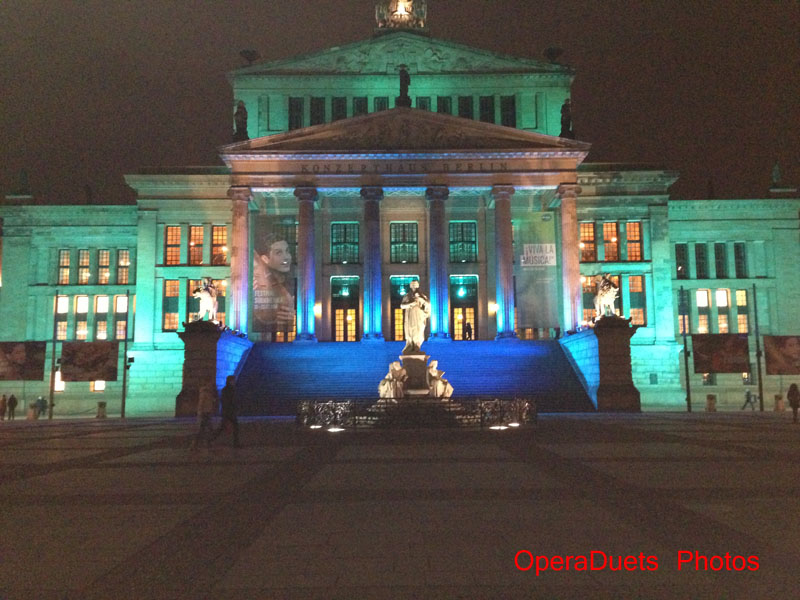José Cura, tenor
Claudio Bohórquez, Violoncello
Konzerthausorchester Berlin
Christian Vásquez, conductor
This time I was in Berlin for a concert of South American music. It was a nice trip. Another time something I did just because Jose Cura would be there singing Argentinian songs.
A reviewer of the concert said that Cura seemed to be uncertain and not fully himself until he sang Aurora by Panizza. He must have been on another concert. The concert was on Friday 21, Saturday 22, and Sunday 23., I was there on Saturday, the reviewer was probably on Friday. I cannot be sure that he was wrong since I only attended the concert on Saturday but I think he was mistaken. Of course a tenor would sing an opera aria with a fuller voice than he would sing the delicate classical art songs of Guastavino and Ginastera. Aurora is an opera by Panizza, the Intermezzo Epico is an Opera Aria. The songs of Guastavino and Ginastera are canciones. With Aurora comes the Opera Tenor Jose Cura, with the canciones comes the recitalist Jose Cura. On Saturday Cura showed that he can sing with his sweetest voice what must be sung so and with more forceful when the text demands it. This is fine and delicate work done by a master. Everybody knows Jose Cura as a operatic tenor with his famous Otello, Samson, Calaf. So those who expect to hear something more like Otello find something familiar when he sings the Song to the Flag from Aurora.
I must say that I liked best Huapango by Moncayo. The orchestra works of Ginastera was too much noice. Of course, the cello player was divine. I loved the conductor. And Jose Cura was wonderful!!!
2014-02-22 Konzerthausorchester Berlin, Christian Vásquez, Konzerthaus Berlin
José Cura, tenor
Claudio Bohórquez, Violoncello
Konzerthausorchester Berlin
Christian Vásquez, conductor
PROGRAMM
Silvestre Revueltas (1899 – 1940)
„Sensemayá“
Alberto Ginastera (1916 – 1983)
Konzert für Violoncello und Orchester Nr. 1 op. 36
ADAGIO MOLTO APPASSIONATO
PRESTO SFUMATO – TRIO NOTTURNALE
ASSAI MOSSO ES ESALTATO – LARGO AMOROSO
José Pablo Moncayo (1912 – 1958)
„Huapango“
PAUSE
Carlos Guastavino (1912 – 2000)
„Las nubes“ (Die Wolken)
Texte: Luis Cernuda Orchesterbearbeitung: Guillo Espel
JARDIN ANTIGUO (DER ALTE GARTEN)
DESEO (VERLANGEN)
ALEGRÍA DE LA SOLEDAD (DIE FREUDE DER EINSAMKEIT)
Albero Ginastera
Tänze aus dem Ballett „Estancia“
DANZA FINAL (MALAMBO). ALLEGRO
Carlos Guastavino
Tres canciones
Texte: Luis Cernuda Orchesterbearbeitung: Guillo Espel
VIOLETAS (VEILCHEN)
PÁJARO MUERTO (DER TOTE VOGEL)
DONDE HABITE EL OLVIDO (WO WOHNT DAS VERGESSEN)
Alberto Ginastera
„Cancion al árbol del olvido“
(Lied auf den Baum des Vergessens, 1938) Text: Fernán Silva Valdés
Arturo Márquez (*1950)
„La Conga del Fuego“
Héctor Panizza (1875 – 1967)
„Intermezzo Épico“ aus der Oper „Aurora“
2 extra orchestra numbers, first was very famous and catchy but I don't remember what it is called, last one was Mambo from West Side Story by Leonard Bernstein.
Then it was night talk with Jose Cura. My batteries was empty so no photos from the concert and only phone photos from the night talk in the music club.
This page was last updated: June 20, 2022

